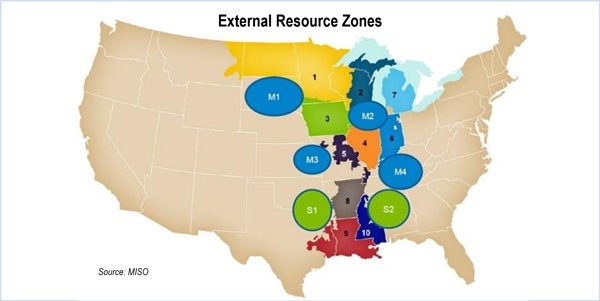By Amanda Durish Cook
CARMEL, Ind. — MISO will continue its current treatment of the sub-regional transfer limit in the Planning Resource Auction, both in deciding the initial limit and subtracting firm transmission reservations, RTO officials told the Nov. 2 Resource Adequacy Subcommittee meeting.
Under that same approach, the preliminary limits for the 2017/18 PRA are 984 MW for South to North and 3,000 MW for North to South, MISO Director of Forward Operations Planning Kevin Sherd said.
The RTO said it believes its approach — which deducts firm reservations from 2,500 MW for flows South to North and 3,000 MW for North to South — curbs the curtailment risk that use of non-firm contract paths could introduce.
Some stakeholders had argued for changing the value used in the initial limit and possibly reassessing the deduction of firm flows from the limit, saying the current approach was overly conservative as not all firm reservations are used.
MISO is also at the center of a FERC complaint filed by its transmission customers, which argue the limit is too strict and traps capacity in MISO South, driving up clearing prices. (See MISO Recommends No Change to Transfer Limits.)
The RTO is expected to publish the final sub-regional import and export limits before March 1. Sherd said MISO plans to continue to evaluate the sub-regional limit methodology for future auctions.
WPPI Energy engineer Steve Leovy said MISO should still consider alternatives to the calculation of the limit.
RASC liaison Renuka Chatterjee said subtracting firm reservations in the sub-regional limit is consistent with the treatment of other capacity import and export limits. Leovy said the treatment was not equitable since the RTO considers pseudo-ties in capacity import and export limits and does not model pseudo-ties in the sub regional limit.
No Change to External Resource Treatment, Either
MISO also is electing not to change the PRA’s treatment of external resources any earlier than other auction changes set for the 2018/19 planning year.
MISO Manager of Resource Adequacy John Harmon said after careful consideration, the RTO will not introduce a locational construct in the 2017/18 PRA. Instead, MISO is seeking a permanent solution as part of a larger bundle of auction changes, including a seasonal construct and separate forward auction, in time for the 2018/19 planning year. The RTO had suggested that it could roll out six new external zones in the capacity auction next year. (See “MISO to Move Ahead with Brattle Demand Curve for Forward Auction,” MISO Resource Adequacy Subcommittee Briefs.)
“We feel strongly that changes regarding a locational construct should be part of a larger reform and not a one-off change,” Harmon said. He added that MISO is looking to do its due diligence on a more comprehensive solution and avoid the “whiplash” of adopting one interim solution then distancing itself from the temporary solution by the time it formulates permanent rules.
Dynegy’s Mark Volpe said that while he appreciated the RTO’s desire to develop a permanent solution, external resources should not be on equal footing with resources in zones inside the RTO’s footprint.
MISO will continue discussion of external zone creation in 2017.





